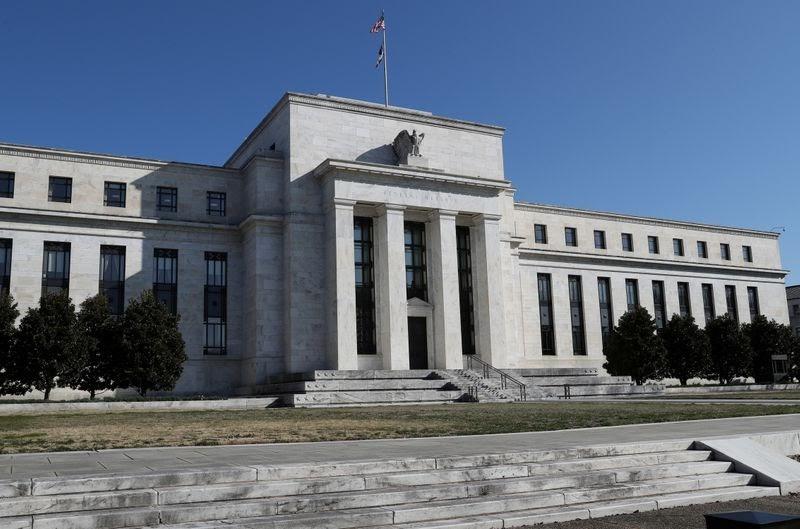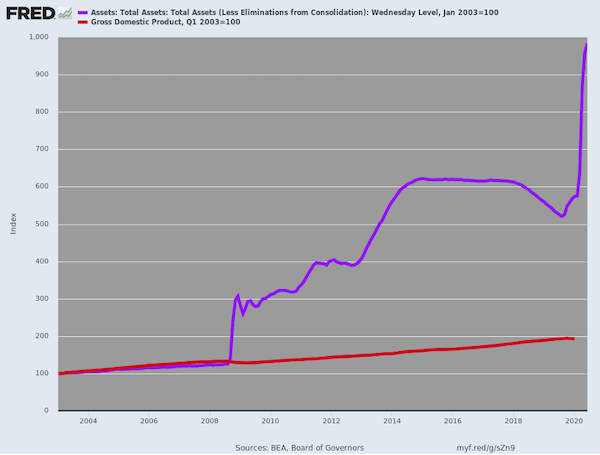Modern Monetary Theory Is Playing With Fire
Tyler Durden
Sat, 08/08/2020 – 19:00
Authored by Ethan Yang via The American Institute for Economic Research,
Like it or not Stephanie Kelton is an economist whose ideas are making a huge splash in the world of economic thinking. She currently serves as a professor at Stony Brook University but more notably served as the Chief Economist on the Senate Budget Committee as well as the senior economic advisor to the Bernie Sanders presidential campaign. This background should give you some insight into her latest book, titled The Deficit Myth: Modern Monetary Theory and the Birth of the People’s Economy.
Published in 2020, this book may be the flagship literature of Modern Monetary Theory (MMT), as it is not only accessible to the average person but also well-written. Perhaps that is also what makes this book rather dangerous as it combines rigorous theoretical concepts with rather deceptive analogies about how these ideas might work, and a decent amount of progressive political talking points.
It is part textbook, part persuasion, and part manifesto. Despite my disagreements with the content, I must admit that it is a thought-provoking piece of literature that provides insight on what may be a very real economic idea to be reckoned with in the near future.
The Myth Surrounding Deficits
Dr. Kelton starts off her book with a basic point about the way the federal government works. Contrary to the way most politicians talk about the federal budget, there is nothing necessarily wrong with running a deficit and accumulating debt. Economists can debate to what extent debt accumulation and spending are healthy but a basic tenet of MMT is the universal truth that the United States government can spend money it doesn’t have. Kelton writes
“What if the federal budget is fundamentally different than your household budget? What if I showed you that the deficit bogeyman isn’t real? What if I could convince you that we can have an economy that puts people and the planet first? That finding the money is not the problem?”
The foundation for MMT is the idea that the federal government is different from a household in that it does not need to raise money before spending it, that it can accumulate debt without any constraints on its fiscal capabilities. The United States government can and has routinely printed money it wishes to spend even though it may not physically possess it, such as the most recent stimulus checks in response to COVID-19.
With a yes or no vote the federal government has spent trillions of dollars that have not been generated from tax revenue or borrowing money. This is possible because the government is a money supplier. It has a monopoly on currency production and can print as much money as it desires.
Whether or not it should spend more than it brings in with taxes is another debate entirely. The core foundation of MMT is the fact that a sovereign currency issuer like the United States, Japan, or Australia can continue to print money and therefore never run out. Under this logic, budget deficits are simply imaginary constraints; the real constraints to spending lie elsewhere.
Dealing With Inflation
This shift in understanding as described by Kelton is that
“MMT clarifies what is economically possible and thus shifts the terrain of policy debates that get hamstrung over questions of financial feasibility.”
In a way, governments around the world essentially practice MMT in a limited capacity as they print the money they don’t have to use in complicated monetary maneuvers. However, Kelton and MMT advocates believe that we should take this way of thinking to its limits. She extols the possibility of building new infrastructure, improving healthcare, and essentially funding a whole slew of projects that would otherwise be impossible without excessive taxation.
Essentially we can have our cake and eat it too, getting more government services without higher taxes. Obviously one of the main concerns with this idea is that inflation would skyrocket if we simply pumped trillions of dollars into the economy. If inflation gets out of control, the country will follow in the steps of Weimar Germany, Venezuela, and Zimbabwe, dooming us to economic collapse. Kelton addresses this concern by clarifying
“Do I believe the solution to all our problems is to simply spend more money? No, of course not. Just because there are no financial constraints on the federal budget doesn’t mean there aren’t real limits to what the government can (and should) do. Every economy has its own internal speed limit, regulated by the availability of real productive resources.”
Powerful economies like the United States can afford to print and spend more money than a country like Haiti. MMT doesn’t necessarily posit that poor countries can print themselves to prosperity, more so that all countries with sovereignty over their currency can increase their potential by printing more money. Policymakers also need to be cognizant of what she refers to as “slack” in the economy which would be underutilized resources and opportunities. If there is enough “slack” in the economy, printing money will not result in inflation as productivity would increase with the money supply.
The main problem with this premise, however, is trusting politicians and bureaucrats to make these incredibly sophisticated decisions. How could one know how much capital exists in the economy and what the correct amount of money to print in proportion to economic growth will be? This is a knowledge problem that needs to be reckoned with before we embark on this highly theoretical trip to the monetary unknown.
The Sovereignty of Currency
Kelton reminds us that the idea of balanced budgets and deficit constraints may have been important in the past when we were on the gold standard but now that we have moved into the world of fiat currency these restrictions no longer apply. This is again true; however, she believes we should take the idea to its logical extreme.
To explain the importance of monetary sovereignty she explains that
“In addition to the United States, countries like the United Kingdom, Japan, Canada, and Australia enjoy a high degree of monetary sovereignty… Some nations have weakened their monetary sovereignty, either by pegging their exchange rates (e.g. Bermuda, Venezuela, Niger), abandonment of their national currencies (e.g., all nineteen countries in the Eurozone, Ecuador, Panama), or by borrowing heavily in US dollars or other foreign currencies (e.g. Ukraine, Argentina, Turkey, Brazil). Doing any of these things compromises a nation’s monetary sovereignty and diminishes policy flexibility.”
By diminishing their monetary sovereignty, these countries have lost their capacity to print money in order to execute policies like stimulus spending during economic downturns and financing more government programs.
She adds that
“Most developing countries are at the weaker end of the sovereignty spectrum…That’s because most poorer developing nations rely on imports to meet vital social needs.”
Although this is certainly correct, whether or not this is the reason why some countries are poor or whether or not increased government spending will be more helpful in developing countries is another debate to be had. Whether or not that is a good thing would depend on whether one sees government intervention as the source of prosperity rather than the private sector. Does the government have a significant role to play in directing the economy like the Soviet Union or should it simply guarantee life, liberty, and property so that its enterprising citizens are free to prosper in a way they choose?
Lastly, if countries with strong currencies decide to do as Kelton says and start printing trillions of dollars to finance projects even if it’s proportional to inflation what message will that send to users of the currency? An article in Forbes warns that
“These numbers are so large that they no longer have any meaning; they are simply abstractions,”
“Pointing to warnings made by former Fed chairman Paul Volcker that “it is a governmental responsibility to maintain the value of the currency they issue. And when they fail to do that, it is something that undermines an essential trust in government.”
“After you throw a few trillion dollars around, people start to believe that it’s all a big joke.”
Perhaps the United States can get away with a COVID-19 stimulus bill and maybe we can afford to finance a round of infrastructure improvements by printing a few trillion dollars. But what about the next round of repairs, the next crisis, the next pressing issue our government is called upon to address? Can we just keep printing more money and is this sustainable? These are some of the ultimate questions that proponents of MMT must address if this theory is ever to be viewed as sustainable.
The Role of Taxes
One of the immediate questions one may have when presented with a monetary system that proposes to pay for everything with the printing press, and that budgets are now irrelevant, is why should we keep paying taxes?
Kelton is very upfront with her view of taxation, which isn’t to raise funds for programs as the government is already the sole provider of currency. It is as she writes,
“To get the population to do all that work, the government imposes taxes, fees, fines, or other obligations. The tax is there to create a demand for the government’s currency. Before anyone can pay the tax someone has to do the work to earn the currency.”
Kelton contends that money was first distributed by the government. In order to make it worth something, the government imposed taxes so that people could exchange them for government services and also work to earn the government’s money. Government is therefore responsible for creating the medium of exchange that society uses to conduct trade and also incentivizing people to conduct useful activity.
According to Kelton taxes serve four essential purposes:
-
To incentivize work by creating demand and scarcity for money
-
To manage inflation by taking money out of the economy
-
To redistribute income
-
To discourage negative activity like smoking and carbon emissions
In this view, taxes do not exist to support the operations of the state through a democratic process agreed upon by the electorate, but to simply exercise the levers of power.
The conventional theory of money and taxes is that money arose as a convenient medium of exchange amongst individuals in the marketplace desiring a universal system of value exchange. That productive activity exists regardless of government and taxation is a process in which the government either forcefully or consensually takes from the population to fund generally agreed upon public services such as raising a military.
These are two fundamentally contrasting views of the role of the state; one positing that it is the central component that enables civilized life and the other holding that it is an entity that is supported by the fruits of a civilized society and is, therefore, a humble servant.
Some Thoughts on MMT
Aside from the concerns with the monetary aspects of MMT such as controlling inflation, maintaining confidence in our currency, and embarking on an unprecedented experiment in monetary theory, I am most concerned with the political economy surrounding MMT.
Kelton contends that such policies will create a “people’s economy” where politicians and not the Federal Reserve will make monetary decisions. Where we will not have to abide by the traditional constraints created by budgets, interest rates, and so on. On this topic, AIER has written extensively on why we should not politicize the Federal Reserve and monetary policy more generally.
Kelton also makes the case for a federal jobs guarantee financed almost entirely by printed money. She contends that such a program would help alleviate job disruption brought about by technological advancement, recessions, and industry disruptions brought about by free trade. This will cost an obscene amount of money combined with the other promises she makes to fix infrastructure, fund Social Security, and provide free college, fund a Green New Deal, and so on.
How can we know this will fit within the appropriate spending to economic growth ratio that she keeps reminding us is the real consideration we should be making? Furthermore, a federal jobs guarantee alongside all the other government programs she advocates for will crowd out productivity from the private sector. Large government programs such as a jobs guarantee will not only artificially divert labor and capital from productive sectors, but it will also drive up inflation when countless individuals are being given checks for government jobs that may not be adding any value to the economy.
If the country embraced MMT, there would be massive concerns with cronyism as politicians would be unleashed to give virtually as much money to their friends as possible. There will be a populist tug of war over the printing press as the different political interests attempt to supercharge their favorite spending habits. The electorate, emboldened by the prospect of simply enriching itself with the printing press will trap politicians in a position where the one who promises to print the most money wins. We don’t need to look any further than the current welfare state to see this in action. If this happens then the careful management of the money supply and inflation which Kelton holds as the main concern with making MMT work will be broken in short order.
Finally, there is a question about the very role of government. Kelton contends that MMT will make it more democratic. I believe that unchaining the state from the constraints of budgets and taxation will make it more despotic. Whatever the government can give, it can also take. MMT seems to favor one that can give endlessly and take everything.
When we look to the state, do we see a deity to kneel before? Or do we see a government instituted among men, deriving its just powers from the consent of the governed? A government that will live and serve within the means that which we democratically assign to it.
Kelton may be right that the old mechanisms of the gold standard, balanced budgets, and debt may be instruments of the past in the face of MMT and fiat currency. However, they also provide a service that goes beyond money and finance. That is maintaining a government that is prudent, humble, and sustainable.
Conclusion
Stephanie Kelton’s book is well-written and serves as an accessible insight into the world of Modern Monetary Theory. Although I have many objections, I found it a great read nonetheless, especially knowing that this is a field of economic thought that may be much more relevant in the near future. There are parts of the book that are essential pieces of economic knowledge that define the modern state, some that are questionable premises, and some that are blatant political talking points. As a contribution to economic thought, I find it to be rather questionable. It also features circular logic, as well as bait-and-switch style arguments. As an accessible insight into an increasingly relevant monetary theory and the world of public finance, I believe the book does just that.
via ZeroHedge News https://ift.tt/2XK0sae Tyler Durden



